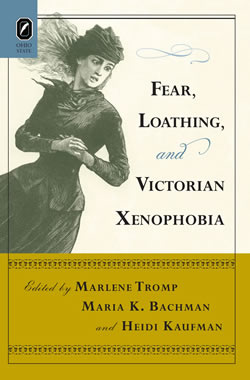Fear, Loathing, and Victorian XenophobiaEdited by Marlene Tromp, Maria K. Bachman, and Heidi Kaufman |
10/3/2013 | |||
|
|
“Tromp (Arizona State Univ.), Bachman (Coastal Carolina Univ.), and Kaufman (Univ. of Oregon) have compiled an impressive collection of essays on the phenomenon of xenophobia, a term coined in 1909. Not counting the introduction and the afterword, the book includes 14 essays, divided into three parts: ‘Epidemic Fear,’ ‘Xenophobic Panic,’ and ‘The Foreign Invasion.’ Each of the editors contributes an essay. In the opening essay, ‘The Pollution of the East,’ Tromp discusses the British Empire’s ironic distrust of its own wealth as this wariness manifests in novels like Dickens’s Little Dorrit and Edwin Drood. Bachman reminds readers of Dickens’s suspicious view of foreign alterity, contrasting it with the more balanced approach of Wilkie Collins, collaborator in Household Words. Kaufman examines George Eliot’s Daniel Deronda and its depiction of Jewish identity. Patrick Brantlinger’s ‘Terrible Turks’ bears reading both for its astute tracing of the mercurial Victorian posture toward Islam and for the implications of the present tortured view of Islamic cultures. And Joy Sperling examines the ‘real mandate’ of the Crystal Palace Exhition. Written by established scholars, all of the essays, as Anne Kershen observes in the afterword, addresses the need ‘to overcome the negativity’ of xenophobia and racism. Summing Up: Highly recommended. Upper-division undergraduates, graduate students, researchers/faculty.” —L. A. Brewer, Georgia Northwestern Technical College “Fear, Loathing, and Victorian Xenophobia makes a significant contribution to the field of nineteenth-century studies by extending the critical lens beyond the imperialist mission to a more widespread and psychological condition.” —Natalie McKnight, professor and chair of humanities, Boston University “Fear, Loathing, and Victorian Xenophobia makes a significant contribution to nineteenth-century literary and cultural studies by highlighting how various and overlapping modes of difference—class, race, cultural, ethnic, national—elicited a host of xenophobic responses that marked Britain’s long nineteenth century. In so doing, the volume adds a much-needed thickness to discussions of xenophobia.” —Sukanya Banerjee, associate professor of English, University of Wisconsin-Milwaukee In this groundbreaking collection, scholars explore Victorian xenophobia as a rhetorical strategy that transforms “foreign” people,
bodies, and objects into perceived invaders with the dangerous power to alter the social fabric of the nation and the identity of the English.
Essays in the collected edition look across the cultural landscape of the nineteenth century to trace the myriad tensions that gave rise to fear and
loathing of immigrants, aliens, and ethnic/ Marlene Tromp is professor of English and Women and Gender Studies and Director of the Division of Humanities, Arts, and
Cultural Studies at the New College of Interdisciplinary Studies, Arizona State University. Maria K. Bachman is professor
and chair in the Department of English at Coastal Carolina University. Heidi Kaufman is associate professor of English at
the University of Delaware. | |||



